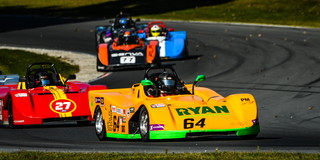
I think we can all agree that race cars are cool. They’re colorful, make loud noises, and they’re fast. As racers, we can’t wait to drive them. Whether it’s our own car, a friend’s car, or the car of a student you’re instructing, you need to know five specific things before you actually drive the race car. These five things can ensure you don’t harm the car (especially if it isn’t yours) and help you to perform better in the driver’s seat. Some of the things can also save your life.
The more you attend SCCA® events, the more likely it is that you’ll find yourself driving someone else’s car. When those opportunities arise (sometimes in a rushed manner before a session begins), we sometimes forget that almost every race car is different. Switches are in different locations, interiors have been modified (including door handles), and cars come with different transmissions, with engines having different redlines.
So before you head out on track (or the autocross course, or RallyCross course…), it’s time to educate yourself about the car you’re in. Buckle up, bud, because here are the five things you need to know.
1. Know How to Get Out!
Like I said, race cars are colorful, loud, and fast, and thus these machines just beg you to climb inside. I remember being 8-years-old and walking around the paddock of a track with my dad and a pro racing team member asked me if I wanted to sit inside their race car. “Please, Dad!”
I remember the smell of oil and rubber, the simplicity of the interior, and the stiff driver’s seat. They buckled me into the five-point harness and closed the door. My dad snapped a Polaroid. Then somebody said, “OK, try to get out!” That was when I realized I had no idea how to get out. Everybody had a laugh at my expense, and I learned an important lesson: Know how to get out of an unfamiliar race car.
(Harness manufactures often use different mechanical systems to release the belts. You need to be able to manually disconnect the belts simply by feel.)
Many years later, I built my own road racing car out of a 1990 Acura Integra. To make the car as light and fast as possible, I cut about everything I could out of the interior, including the insides of the doors. In order to get the door latch to work from the driver’s seat, I used a thin metal cable that I made a loop out of and passed through a small hole in the door. You tugged on the loop and the door opened. I thought it was pretty ingenious, but I was the only person who knew how to open the door. Nobody else could figure it out...until I told them.
The point is, every race car is different, but regardless of those differences, you still need to be able to get out of a car in case of an emergency. And race cars are becoming harder and harder to get out of. Some cars are now running two window nets on the left side (do you know how to get them both to drop?). Also, driver harness releases are not universal (do you twist to disconnect or flip up a lever?). Some cars have fixed plexiglass side windows that you can’t lower. Did some shade tree race engineer remove the door handle and replace it with a hard to see piece of wire?
Simply put, before you drive a race car, make sure you can get out quickly.
2. Know Where the Kill Switch Is
Nearly all road racing cars come with a kill switch – and they’re never in the same location. Before you drive a car, you need to be familiar with the location and operation of the kill switch (by feel, not just sight) because when things go wrong (and in racing, things sometimes go quite wrong), you will want to kill the fuel pump and/or shut the engine off quickly.
In other words: Make sure you can reach the kill switch and be intimately familiar with how it operates so if smoke fills the cockpit, you can still switch it off.
This isn’t just for full blown race cars. Some stock cars use key fobs with push button starts that have their own manufacturer-specific requirements – not everybody knows that the start button needs to be pressed and held down for a few seconds to turn an engine off. Every car is different, and it’s your job to know those differences before heading out on course.
Conversely, it helps to know how to start a car, too. This may sound elementary, but many race cars have different styles of push button starts mounted at random locations. If the car comes with a manual transmission, you may need to depress the clutch before hitting that button or turning the key. If the car owner has disabled the clutch switch, then you need to ensure the car is in neutral before you hit the starter switch (or the car may lurch forward or backward). Some race cars have a random, non-labeled switch to power the car (for anti-theft measures…or because they never got around to labeling it). In short, unless you ask, you may have no idea how to start the car.
And for modern cars, it helps if the car owner doesn’t walk away with the key fob in their pocket. That’s not a good start (pun intended) to a fun time.
3. How Does the Fire Suppression System Work?

(It’s important to know how to use a car’s fire suppression. Do you push the handle or pull the handle? It could be activated by a button on the dash, or it could even be temperature activated.)
The last thing you don’t want to know how to operate is the fire suppression system – because when things get hot in a race car (like you’re “on fire” hot) panic sets in. Fire is always a possibility in a race car, so you need to know how to deal with it if it happens.
Some race cars have fire suppression systems that are charged and plumbed to fight fires in the cockpit, the engine bay, and near the fuel tank. But how those activate differ greatly. Some self-activate with a big enough impact or extreme temperatures, while others need to be activated by the driver. Some have a pull handle, some have a push handle, some are just a button on the dashboard, and some need to have a pin pulled prior to going on track so the handle will work.
Sound complicated? It’s not – but at the same time, it is. This is exactly why you need to know how the system works before you leave the paddock.
Pro tip: Don’t test it! Unless you want to get wet, have chemicals all over your driving suit, and you want to pay to recharge the system. Just understand how it works and how to activate it from the driver’s seat – again, by feel, not sight.

(If a race car uses a handheld extinguisher, do you know how to remove it from the vehicle to use it? Does it have straps or a different method that holds it to the car with a quick release?)
Some cars, meanwhile, utilize a handheld fire extinguisher. That may seem easy, but believe it or not, even these can get complicated. Handheld units generally need to be easily accessible and quickly removable, but they also need to be secured to the car in a way that they can’t become loose during a race. This means accessing a handheld extinguisher is different from car to car. Make sure you know how to remove a fire extinguisher and to pull the pin so you can use it to put out a fire. Trying to figure this out while a fire is going on is not the best way to learn.
4. Manual/Automatic? What is the Shift Pattern? How Many Gears?
One of the first times I drove somebody else’s car at an event, I didn’t drive it at all. I was given an invitation to drive, and I jumped into a friend’s VW Rabbit. I was super excited. My friend parked it with the front of the car near a concrete pit wall and then left to get a hot dog. All I needed to do was back the car up and hit the track – but I couldn’t make the car go backwards because I couldn’t find reverse. I had no clue I needed to push down on the shifter to engage reverse.
Obviously, I missed that session on track.

(Did your friend replace the OEM shift knob (you know the one with the shift pattern delineated on top)? You better ask them how many gears the car has and where they are.)
It may sound dumb, but you need to ask how many gears the car has, as well as what the shift pattern is. Trying to find fifth gear at speed and discovering reverse instead is an expensive mistake (it’s also the last time you’ll be asked to drive anybody’s car). If the car is an automatic, how do the paddle shifters work (left is down shift and right is upshift?).
Find out how the transmission works before you start moving, or you may not move at all.
5. What is the Acceptable Redline?
The fifth and final thing to know before climbing into a race car is what the redline is. If the car’s highly modified, there’s a chance the redline isn’t what’s printed on the gauge. In fact, the car may not have a rev limiter at all. Meanwhile, the owner may not want you to stretch the rods out at 9,000 rpm.
Come to think of it, can you even see the tachometer from your driving position? We all love jumping into other people’s cars to drive them, but nobody enjoys buying their friend a new engine and then spending two weekends at their house busting knuckles to install it. Know what the acceptable redline is – and then just as important: respect that number.

(Can you see the tach? And does this car come with a rev limiter? If not, what’s the redline and what is the acceptable shift point? In other words, do you want to buy an engine?)
The next time you get that irresistible offer to drive somebody’s race car remember these five key things: How to get out, how to use the kill switch, how the fire system works, where the gears are, and what the redline is. After that, it’s sweet #funwithcars!
(About the author: Rob Krider is a national champion racer, the author of the novel Cadet Blues, and is the host of the Stories and Cocktails podcast.)
Photos by Rob Krider











